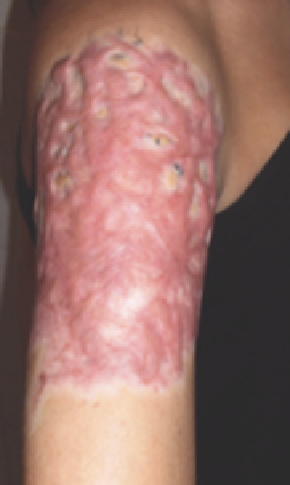Biomedical Engineering Reference
In-Depth Information
(
A
)
(
B
)
Figure 4.1
Chemical Peel. (
A
) A black ink tattoo and (
B
) hypopigmentation with minimal ink resolution following a chemical peel.
Figure 4.2
Salabrasion. Hypopigmented scarring after salabrasion.
dermabrasion and other mechanical tissue
destruction techniques
Tattoo removal via mechanical tissue destruction, most com-
monly, dermabrasion, is rarely seen today. To remove as much of
the tattoo pigment as possible, a rapidly spinning diamond fraise
wheel or a wire brush was used to abrade skin that had been
frozen with a skin refrigerant to produce a hard surface (78,81).
This tended to be bloody with tissue and blood particulates of a
size that can access the pulmonary and mucosal surfaces, aero-
solized in the operative suite (168), with potentially infectious
agents. Subsequent scarring was worse if complete pigment
removal was attempted in one session by creating a deep wound
to the full depth of the tattoo pigment (Fig. 4.3). Removing tis-
sue only to the depth of the papillary dermis (79) minimized
scarring but left a significant tattoo pigment, required additional
procedures, and thereby increased the potential for scarring. To
enhance the efficacy of the procedure, gentian violet (95,169) or
tannic acid and silver nitrate (79) were applied to the superficially
abraded surface, and exposed pigment was curetted (170) or
removed with fine tweezers (99,171). Other mechanical treat-
ments no longer used today include linear incisions, scratches,
punctures (95), or a grid of crisscross abrasions followed by
application of a caustic chemical. The author has also seen
attempted tattoo removal with a “belt sander,” which is used to
sand down wood for fi nishing purposes.
Figure 4.3
Dermabrasion. Hypertrophic scarring and ink retention after
dermabrasion.
Figure 4.4
Excision. Partial tattoo removal following surgical excision.
the use of tissue expanders (115) are often necessary to repair the
tissue defect created by excisions of tattoos. Split-thickness tan-
gential excision without grafting has been reported as well (173)
but has the same limitations as dermabrasion. Surgical excision
may result in incomplete tattoo removal (Fig. 4.4), tissue distor-
tion, and scarring because of limitations in wound closure and
healing—results that are often unacceptable to the patient.
surgical excision
Small tattoos located in areas of adequate skin laxity allowing
primary closure without excessive tension can be removed satis-
factorily with simple excision (109). However, this situation does
not occur often, and complex wound closures (95,104), skin
grafting (95,172), multistage excision (95,99,109,138,153), and


















